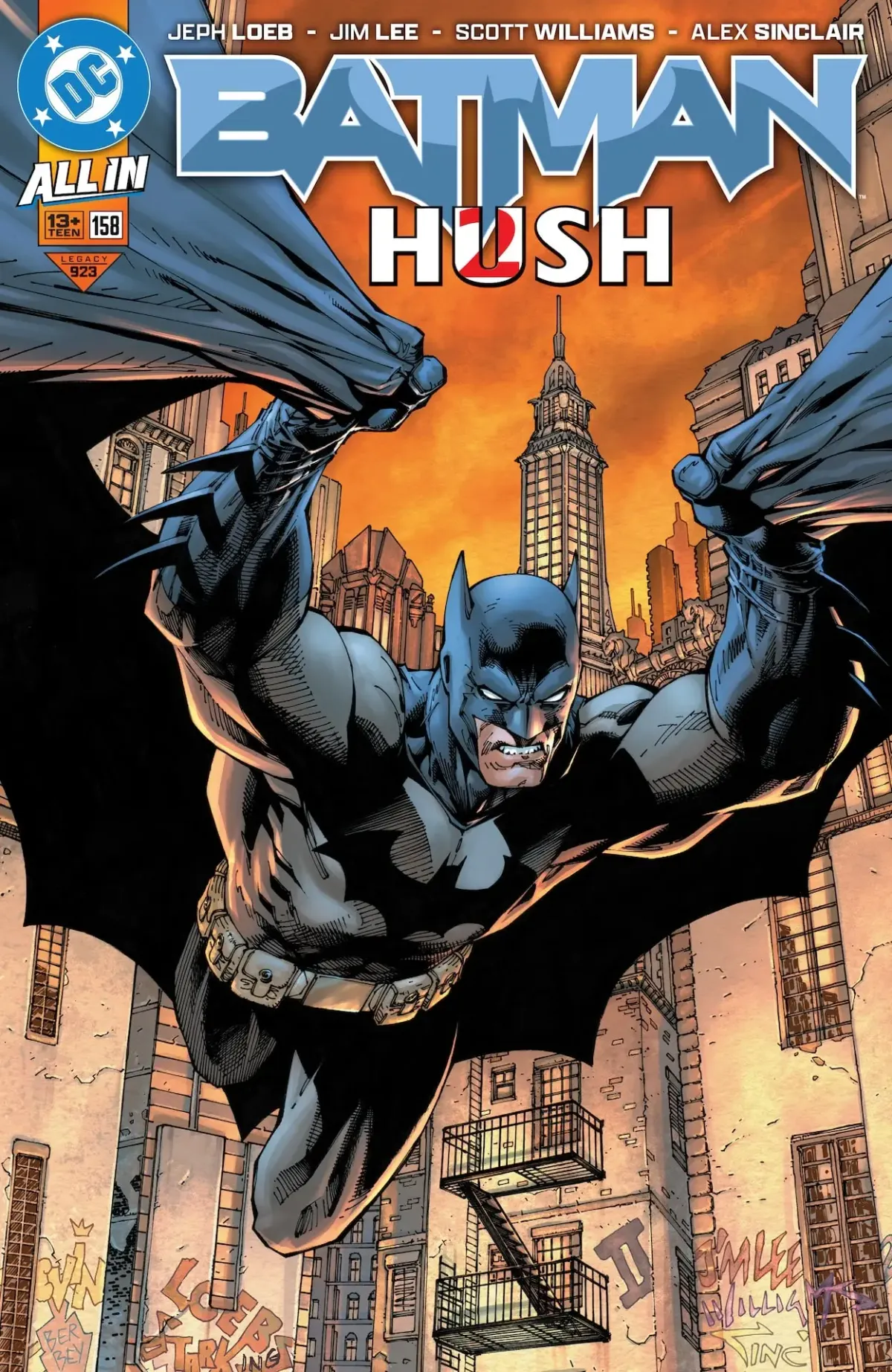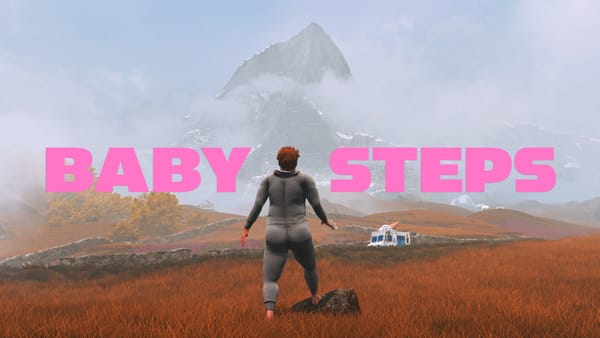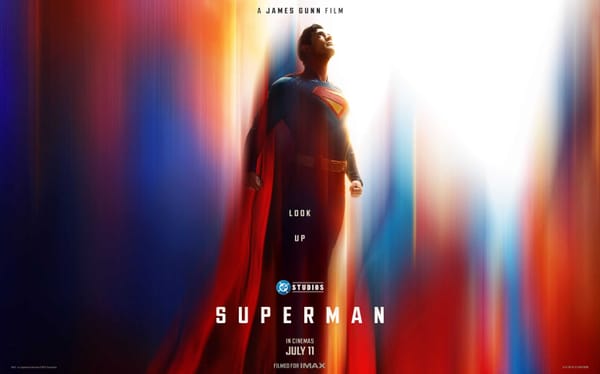Batman #158 : H2SH Chapter One

Back in 2002, DC Comics decided to take a big swing. After the endless crossovers spilling into each book since the 90s, they put Jeph Loeb (Batman : The Long Halloween) and Jim Lee (Wildstorm) on the flagship Batman book to tell a self-contained story for a year. Readers were taken on a tour of Bruce Wayne’s corner of the DC universe, with nods to the Golden Age and a trip to Metropolis along the way. Each issue, Batman faced another member of his rogues gallery using all-new tactics under the direction of the mysterious bandaged Hush.
22 years later, Hush is back. This isn’t the first time Hush has been revisited, but it is the first time that Loeb and Lee (and Williams and Sinclair and Starkings) have come together for a true sequel. With the first six issues coming out in the regular Batman comic at the moment and the other six planned to run as a miniseries next year, we’re only at the beginning of the story but I have thoughts.
Here in the UK, Eaglemoss published the DC Comics Graphic Novel Collection from 2015-2021. These collected stories in hardcover volumes, roughly six issues apiece, with a backup comic from the 30s-80s that tied into the main story. They started strong with Hush, making it one of the first full American comic stories I read. In the two weeks between parts one and two, I read and reread the first half all the time. I knew Hush’s identity thanks to LEGO Batman but I was still enamoured with watching the story unfold. When that second volume fell into my hands, I devoured it in one sitting on a lovely summer day. All in all, it was a great introduction to DC Comics and the Batman line in general.
H2SH, as the official advertising calls it, is not a great introduction. This is a story that assumes a lot of the reader to make much sense. It assumes that you’re familiar with Hush, which is fair, but also so, so much more of what has happened in comics both before and after the original story. From the very start, the comic calls back to the end of Batman: Year One (Batman #407, 1987) and The Laughing Fish (Detective Comics #475, 1978). Having dived into comics after enjoying Hush, I know these touchpoints, but anyone coming to H2SH as a straight sequel is going to be alienated from the start. This isn’t to say H2SH is unaware of this. In fact it’s calling back to these stories with a question : why is the Joker reusing his material by repeating older crimes?
Really, the comic is trying to justify retreading the Hush story to begin with, which has a clear answer. The various collected editions of Hush are reliable best-sellers, from the $10 Compact Comics edition to the $150 Hush Saga Omnibus that also collects the scattered sequels. $4 facsimile reprints of comics that were $2.25 have been running up to and alongside the start of H2SH too. For H2SH each issue is $5 each, with a $15 Giant-Size Special Edition also available. I bought one of these editions for the novelty, so consider this review a recoup on that investment.
The self-awareness aside, I would have been confused if handed H2SH straight after reading Hush ten years ago. Why is Oracle back as Batgirl but also still Oracle? Why does the comic linger on a dummy of Jim Gordon outside the amusement park? How is Hush back anyway? And why isn’t the art as good?
In the intervening two decades, Jim Lee has risen to the rank of Chief Creative Officer at DC and become a father who does sketches for charity and $8000 commissions on the side. He’s a busy man being pulled in three directions at any given time. Considering his history of overpromising and missing deadlines over the years – see All-Star Batman & Robin’s final issue coming out a decade after the first, although that was partially down to writer Frank Miller and the comic’s ill reputation, too – I have to wonder why they aren’t waiting until he’s finished drawing the series to start releasing it. None of this explains why I don’t like the art as much, but it all is a factor on top of natural stylistic changes.
When Killer Croc first appears at the start of Hush (Batman #608, 2002), he bursts onto the scene in a two panel spread (drawing our eyes away from the tease of Catwoman’s involvement in the background) in a monstrous new form. When the Joker first appears (Batman #613, 2003), it’s a dramatic splash page at the end of the issue, his hair flying wildly in the wind as he looks straight at you. Both of these are iconic pieces of comic art by Lee, the Joker being reused in all manner of merchandise.

When the Joker first appears in H2SH, he looks smooth. He sneaks up on Batman, who is inexplicably looking away from the van he just fought over, and hits him with a crowbar (which I bet is a Death in the Family reference). Your eyes are drawn to the bar’s arc and its bloody impact, but the smooth Joker detracts from the image. Not a face you would put on t-shirts. He then kicks Batman into the river, leading to the comic’s first splash page where Batman is swarmed underwater by Joker Piranhas. At least, he’s meant to be swarmed but they’re giving him a lot of space. The first big image for the comic and it’s just as smooth, the literal bite in the page not coming through.
When we get a better look at Joker while thrust into the air by new character Silence (missed opportunity to rope in the Silencer), the differences between Hush and H2SH become all the more clear. Here the dull colouring catches my eye, the bold colours the Joker sports in Hush and every other Batman comic nowhere to be seen. The orange of his shirt and the purple of his suit don’t stand out against the grey mountains of the background, nor does the lipstick look remotely red. The whole comic looks like it’s been desaturated apart from the all-red panels that punctuate the Hush’s torture of the Joker, but I’m getting ahead of myself.

After washing up on a nearby shore, Talia Al Ghul rescues Batman while Batgirl and Nightwing dither about in her Clock Tower headquarters. They realise that his signal is being jammed for everyone except them (and Talia) but do they do anything about this? No! Batman monologues about his and Talia’s son Damian while she fixes him up, and then she flies off again in her helicopter. Of all the many parts moving in the two stories, she has changed the least as far as this comic is concerned. We’re then treated to Hush throwing surgical scalpels at the barely-conscious Joker, making the exact cuts needed to make him slowly bleed out.
Back at the Batcave Batman analyses the mud on the Joker’s shoe, left behind by Hush and Silence at the docks, and traces him to the amusement park. Batgirl and Nightwing pop up on the comms while he works, still in the Clock Tower. When they tell him about the signal issues, he assumes it’s a breach and locks their network down. Oracle, why didn’t you do this or at least go check on his last known location in the last hour?
Without another word he sets off for the amusement park, the same one that The Killing Joke took place in judging by the maggot-infested effigy of Jim Gordon stuffed in a ticket booth. That makes three references to other Batman storylines that someone reading this as a straight sequel to Hush won’t get, six if you count Batgirl being back in action (Batgirl #1, 2011), Talia talked about as the mother of Damian Wayne (Batman #655, 2006) and Alfred not being around (Batman #77, 2019).
In the Joker’s lair, Batman navigates a hall of mirrors full of gun-toting Joker arms while the Joker taunts him over the speakers. The taunting goes on as we find the Joker unconscious, pinned to a throwing-knife table with scalpels. Whether it was a pre-recorded message or some kind of deep-fake made by Hush is unclear. I’ll give it to H2SH : I am genuinely curious about if the Joker was willingly tortured just to get to Batman. The issue ends with our hero once again left with his worst enemy’s life in his hands.

It might not shock you to learn that I didn’t love this comic. The original Hush called back to old storylines, like Jason Todd’s death (Batman #427, 1988), the existence of Oracle (Suicide Squad #23, 1989) and Harold formerly being a fixture of the Batcave (Batman #458, 1991) but these felt aspects of a pre-existing world that didn’t demand anything from me. Here it means nothing to a new reader that the Joker is once again messing with the reservoir or dumping fish in it, nor does it mean anything that Batman’s drawn out to the location of the Killing Joke.
I feel that Loeb does a poor job contextualising these references so that they make sense to someone coming to H2SH after enjoying the original. Long-time comics fans like myself can spot these easily, but when the thrust of the plot is villains retreading old stories, it doesn’t work for a newer reader. I know that Jason Todd will be appearing later on in the story and I doubt Loeb will even bother explaining his true return even with the fakeout resurrection being a key part of the original comic.
Batman #158 is a disappointing start that uses a parade of references to iconic storylines in the hope you will mistake it for one of them too. Stories like Hush or The Long Halloween didn’t feel the need to justify their existence or promise anything to the reader. Those classic comics speak for themselves.
Batman #158 is a superhero comic written by Jeph Loeb, drawn by Jim Lee and published by DC Comics. If you enjoyed this review, consider sharing it with others. And if you'd like to support Memory Card, consider backing on Patreon or making a one-time donation.
(The real highlight of this comic was the four page preview of Absolute Martian Manhunter #1 in the back. I hope Javier Rodriguez’s art for the series gets this giant-size treatment down the line.)




